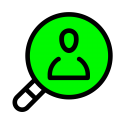OUR CASE
Alan is rushed into the Resus bay in ED to resuscitate and work out what is the cause of his coma
Resus Priorities
Although these are ordered here, keep in mind you will be doing much of this concurrently.
In brief:
> Intubate, carefully, if airway or breathing necessitates, avoid hypoxia
> Get a collateral history
> Do appropriate neuro exam before intubating
> Give naloxone if opiate toxicicty a possibility
> Bedside investigations include BGL, bloods, blood gas
> Give dextrose if hypoglycaemic
> CT, consider CTA & CTV
> Consider LP
Unconscious patients may or may not require urgent intubation.
The main question is whether they are breathing sufficiently and whether they are adequately protecting their airway.
Trauma teaching suggests patients with a GCS of 8 or less should be intubated.
This may not apply to all coma patients and an individual assessment should be made.
TIPS FOR INTUBATION
Do a neurological assessment prior to giving sedation and paralysis
Aim SBP 130-160 mmHg unless specific pathology already known / suspected
Maintain oxygenation, avoid hypotension and avoid further neuronal damage
Use only short acting sedative / analgesic agents
Example neurocritical care intubation here
> When was the patient last known seen well?
> Past medical history, specifically including neurological and psychiatric history.
> Outpatient medication list and any recent medication changes.
> Preceding symptoms (e.g. confusion, headache, abnormal movements, weakness, depression).
> History of substance use
The Essentials
GCS
The most commonly used standard for measuring level of consciousness.
Doesn’t really point to the aetiology
Learn more about doing it here
PUPILS
Pupil size, symmetry and reactivity (CN2 & 3)
BIG (MYDRIASIS, > 5 mm)
Bilateral dilated + fixed
Bilateral midbrain damage causing loss of parasympathetic output from CN3
Hypoxic ischaemic encephalopathy (midbrain damage)
Anticholinergic drugs at high dose (especially atropine)
Extremely deep metabolic coma (e.g. hypothermia, barbiturates, tricyclic antidepressants, lignocaine, sympathomimetics)
Bilateral dilated + reactive
Anticholinergic drugs
Sympathomimetics (e.g. adrenaline given during cardiac arrest; amphetamine, cocaine, methamphetamines, MDMA)
Serotonin syndrome
Generalized seizure, including the postictal period
Unilateral dilated + fixed
Oculomotor nerve paralysis (especially suggested if the involved eye is turned downwards and outwards)
Uncal herniation compressing CN3, which is usually ipsilateral
Posterior communicating artery aneurysm compressing CN3
Outer portion of nerve carries pupillomotor fibers so pupil dilation from compression occurs before eye is down & out / ptosis REF
Midbrain lesion affecting the CN3 nucleus
Focal seizure
Salbutamol or Otrivin (xylometazoline) in the eye (following nebulized or intranasal drug administration)
MID (2-5 mm)
Bilateral Mid and reactive
Toxic/metabolic coma (dysfunction of the cerebral cortex)
Lesions in the dorsolateral upper-mid pons
Bilateral thalamic dysfunction
Neuromuscular blocking drugs are another possibility (smooth muscles of iris don’t get paralysed)
Bilateral Mid and Fixed
Bilateral midbrain damage with loss of sympathetic and parasympathetic output
Profound barbiturate coma
Hypothermia
SMALL (MIOSIS, < 2mm)
Often hard to know if reacting or not!
Bilateral small
Drugs e.g. opioids, cholinergic agonists, clonidine, organophosphates, olanzapine, ACE-inhibitors
Metabolic encephalopathy
Extensive pontine hemorrhage (“pontine pupils”).
Early phase of central herniation syndromes (either upwards or downwards herniation)
Unilateral Small
Unilateral Horner’s syndrome (loss of sympathetic outflow e.g. large thalamic haemorrhage
EYE POSITION
Both eyes looking to one side (horizontal conjugate deviation)
Structural lesion (e.g. stroke) – Eyes deviate ipsilateral to the lesion (S ame S ide S troke) – contralateral to limb paralysis.
Focal seizure –Eyes deviate contralateral to the lesion (Seize Away) – ipsilateral to the seizing limb. Active seizure can be associated with nystagmoid jerks. This may subsequently be followed by a Todd’s paralysis, wherein the eyes deviate in the other direction. REF
Ping-Pong Gaze
Spontaneous, synchronized movements of the eyes side to side
Video
Bilateral cerebral hemispheric dysfunction (e.g. toxic/metabolic coma)
Bobbing & Dipping
Bobbing (quick down, slow up) – pontine lesion
Dipping (slow down, fast up) – bihemispheric dysfunction
Nystagmus
Cerebellar or brainstem lesion
Drugs (e.g. alcohol, anticonvulsants, lithium, ketamine, LSD)
Non-convulsive status epilepticus
Upward gaze
Bihemispheric damage (e.g. hypoxic brain injury)
Downward Gaze
Thalamic injury (e.g. ICH)
Midbrain dysfunction (e.g. Parinaud syndrome )
Bilateral hemispheric dysfunction (e.g. hypoxic brain injury)
Elevated intracranial pressure (rare)
DOLLS EYE TEST
AKA vestibulo-ocular reflex
Only if C-spine cleared
Done like this
If NORMAL – structural cause of coma unlikely
If abnormal, not specific – could be metabolic or structural
CORNEAL REFLEX
Sterile gauze or drop of sterile saline
Come from side so you’re not testing response to visual threat
Corneal reflex preserved until late in coma
If absent, can be metabolic or structural cause
MOTOR RESPONSE
Initially test if obeying 2 step commands e.g. give thumbs up then put it down
If no response to voice:
Central painful stimulus – are they moving symmetrically?
Peripheral painful stimulus – do they respond or withdraw? Is there a central reaction?
Asymmetrical response suggests a focal structural lesion
Decorticate response (abnormal flexion) suggests bilateral damage to diencephalon and upper midbrain
Decerebrate response (abnormal extension) suggests damage to midbrain
Rarely encephalopathies can cause these postures so not 100% structural
COUGH REFLEX
Cough reflex with suction if intubated
Late reflex to be lost
Can be lost in severe metabolic coma e.g. thiopentone
Not present if paralysed!
Don’t do the gag reflex in this setting. Adds nothing and may induce vomiting / aspiration.
BREATHING PATTERN
Different patterns can suggest aetiologies
From higher to lower:
Cheyne-Stokes pattern
Sinusoidal
From a delayed feedback loop involved in regulating CO2 levels
Can be metabolic coma or bilateral thalamic injury as cause
Hyperventilation
Upper midbrain damage may cause this
Apneustic Pattern
Rare
End expiratory pauses
From pontine dysfunction
Ataxic Pattern
Irregular clusters of breaths, not sinusoidal like Cheyne-Stokes
From damage to medulla
TONE
Assess muscle tone, reflexes (knee), clonus (ankle) & Babinski reflex
Increased tone with hyperreflexia or clonus
Toxodrome (e.g. serotonin syndrome, neuroleptic malignant syndrome, malignant hyperthermia)
Seizure
Old upper motor neuron injury e.g. previous stroke, old spinal cord injury
Myoclonus
Usually toxic / metabolic rather than structural
Hypoxic brain injury
Seizures
Drugs e.g. Lithium, Cephalosporin, pesticides REF
Consider
COLD CALORIC TESTING
Also tests Vestibulo-ocular reflex
Only if abnormal Doll’s Eye test, unless in context of brain death testing
Check that ear is clear of wax / blood & tympanic membrane visible
Flush ear canal with 50 ml of ice cold water, bed at 30 degrees
In awake people this is very uncomfortable and may induce vomiting
Normal: eyes deviate towards irrigated side, then fast phase nystagmus away
If normal, suggests a less severe metabolic coma, akinetic mutism or pseudocoma
If symmetrically abnormal, does not differentiate between brainstem pathology or severe toxic / metabolic coma
If focally abnormal, may be CN3, pons or CN6 injury
Opioid overdose is a very common cause of coma
If pupils are small and there is no other obvious cause of coma, give the opiate antidote naloxone
Naloxone IV (*preferred route) 100 – 400 mcg
Naloxone IM 400 mcg
Naloxone Intranasal 1-2 mg to each nostril
> Blood glucose level
Treat immediately if hypoglycaemic!
Dextrose 50% 50 ml
Give 500 mg IV thiamine with dextrose to avoid precipitating Wernicke’s encephalopathy
> ABG for metabolic causes
> Urine tox screen and urine analysis
> Bloods: FBC, EUC, CMP, LFT, Coags
> Think about: TFT’s, arterial ammonia level, blood cultures, CK, Beta HCG, alcohol level, paracetamol and salicylate levels, carboxyhaemoglobin
A non-contrast CT the first imaging required to investigate for structural causes of coma (e.g. ICH, CVA)
If there is clinical and collateral evidence suggesting Acute Ischaemic Stroke a CTA should also be done
A CT venogram may be performed if venous sinus thrombosis is suspected
Perform if:
CNS infection a potential diagnosis
Other exam findings, bloods, and imaging don’t reveal cause
Not contraindicated (CT brain shows no signs of EICP, no mass lesion, no HCP)
For what to send and how to do it see here
Referral may be to any of neurology, neurosurgery, gen med, renal, gastro or toxicology depending on what you find. ICU usually need to know.
Make sure you cover:
> Name
> Age
> Collateral history of presentation if available
> Vital signs
> Coma Neuro exam to include GCS with breakdown, especially motor and posturing, pupils, corneals, eye position, Doll’s eye test, cough reflex, breathing pattern
> Other exam findings that might suggest diagnosis e.g. those of a toxidrome
> Blood glucose, ABG, bloods
> CT result
> LP result
> Treatments given with response
Apart from what you already know about Alan, you ascertain:
His blood glucose is 5.6 mmol/L
He was empirically given naloxone as his pupils remained small, but this had no effect on his level of consciousness
His venous blood gas:
pH 7.25, pCO2 45 mm Hg, PO2 50.9 mm Hg, bicarbonate 16 mmol/L, and Base excess −8 mmol/L.
Bloods available now showed:
WCC was 12,300 cells/mm3
AST 55 IU/L
ALT 42 IU/L
GGT 18 IU/L,
Alk Phos 59 IU/L
Total bilirubin 0.6 mg/dL,
Creatinine 90 mmol/L
Urea 6 mmol/L
CK 1992 mg/dL
CMP normal
A CT brain looked essentially normal, no CTA was performed
An LP was performed and the opening pressure was 12 cm CSF, looked clear and results are pending.
From which group of aetiologies is his coma? (Focal signs / Meningism / No focal signs or meningism)
What’s next in terms of investigations?
Show Answer
From what we know, there are no focal signs and no meningism, so we’re looking at the MESOT group of causes now:
Metabolic
Endocrine
Seizures
Organ Failure
Tox
We’ll look at the next round of investigations in the ICU section that’s coming next.
Often the most useful thing is to get more history…
← Previous TopicNext Topic →


